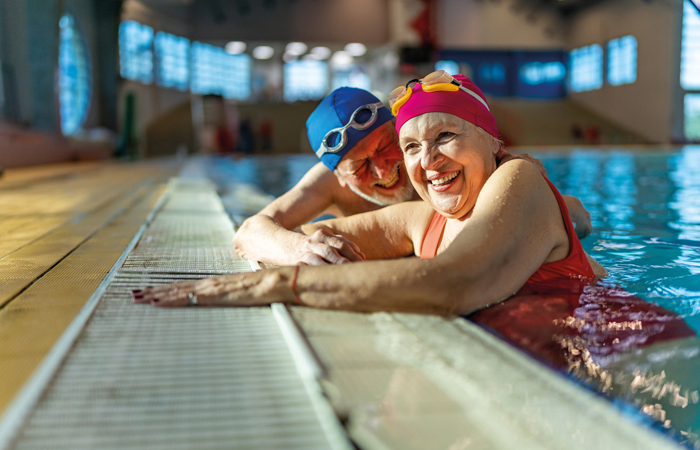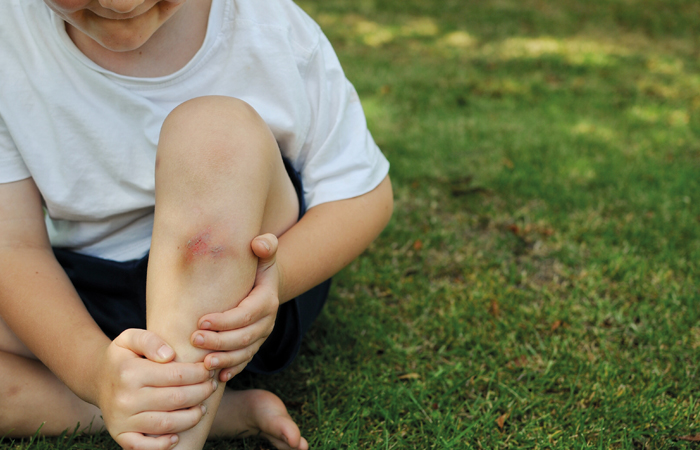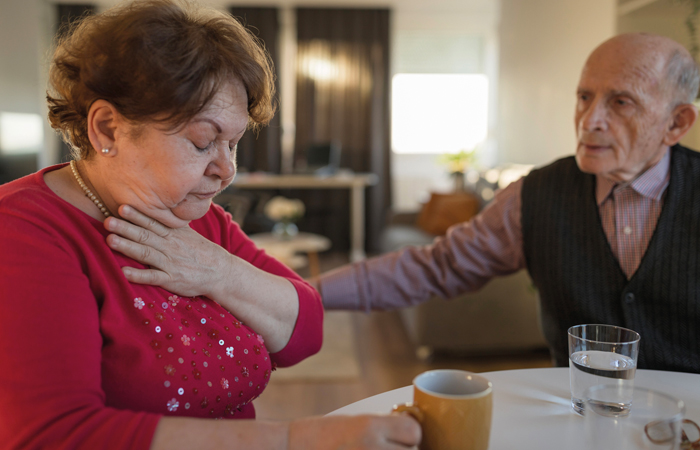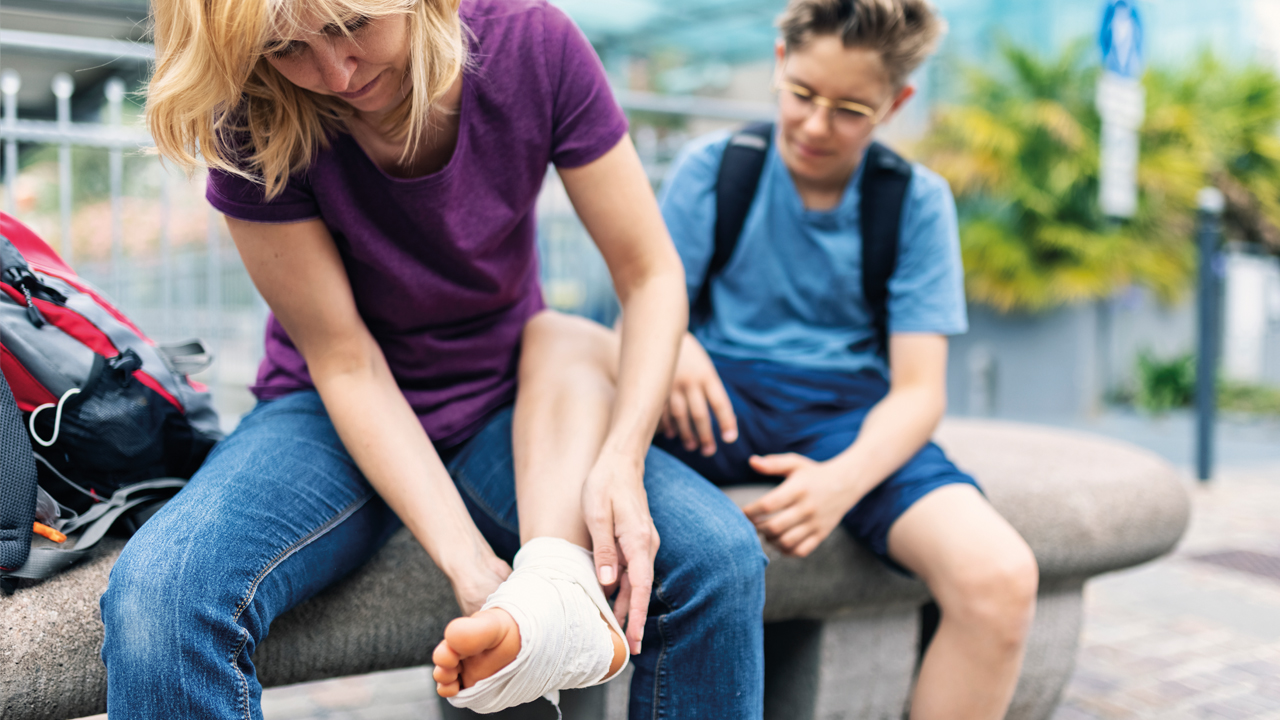In OTC
Follow this topic
Bookmark
Record learning outcomes
Icing a sore foot, cleaning up a graze or knowing how to react to a nosebleed may seem like common knowledge, but they are all treatments that fall under first aid. First aid is the first and immediate assistance given to someone when they become injured or sick, and whilst it is often given by someone with first aid training, everyone can benefit from knowing the basics – including the pharmacy team. William Spencer, community education project manager for the British Red Cross, says: “We’d encourage everyone to learn basic first aid, particularly pharmacy team members who are likely to come into contact with people in need of support as part of their job. With the right training, they’ll be able to directly support people with illness and injuries, offer advice and signpost to other sources of help.”
Common occurrences
Some injuries may need to be urgently referred to A&E, but for minor accidents, pharmacy teams can offer their help and advice.
Burns and scalds
“Burns and scalds are quite a common injury, and they should both be treated in the same way,” says William. “Cool the affected area under running water for at least 20 minutes. Keep the burn clean by covering it with clingfilm or a clean plastic bag. You should call 999 and get medical help if the patient is a baby or child, elderly, or if the burn is serious.”
Cuts and grazes
Other common ailments that can often be treated with first aid knowledge are cuts and grazes. William suggests that “these should be cleaned and covered. If the patient is bleeding heavily, use a clean cloth or bandage and apply pressure to the wound. And again, if the bleeding is serious, call 999”.
Nosebleeds
Nosebleeds are identified by bleeding from one or both nostrils, but other symptoms include dizziness or light-headedness. Chief paramedic officer at St John Ambulance, Martin Berry, advises that when dealing with a nosebleed, “the first and most crucial step is to stay calm and keep the person calm”. The next thing to do is to get them in the correct position. “Have them sit down and lean slightly forward. This position helps prevent blood from running down the throat, which can cause coughing, gagging, or vomiting,” explains Martin. “Using the thumb and index finger, pinch the soft part of the nose just below the bony bridge. Maintain firm pressure for about 10 minutes. Resisting the urge to check if the bleeding has stopped during this time is crucial. An ice pack or cold compress can be placed on the nose and cheeks, the cold helps constrict blood vessels, potentially reducing the flow of blood. After the bleeding stops, advise against blowing the nose, bending over, or engaging in strenuous activities for several hours to prevent re-bleeding.” Customers whose nosebleed persists after 20 minutes of pressure or those with regular nosebleeds should seek medical attention. “If the nosebleed is accompanied by symptoms like high blood pressure, fainting, or difficulty breathing, immediate medical attention is necessary,” Martin adds.
Fainting
While some injuries are only ever sudden and cannot be predicted, fainting can be preceded by various warning signs, Martin notes. “Individuals often report feeling dizzy or lightheaded. Vision changes such as blurriness or tunnel vision are common. Other symptoms include sweating, nausea, a pale complexion, and a rapid heartbeat or palpitations. Recognising these signs can help take preventive measures before losing consciousness.” If someone faints, it is important to immediately assess their responsiveness. “Gently [shake] the person and [ask] if they are okay. If there is no response, check for breathing, if the person is breathing, lay them on their back and elevate their legs about 12 inches to help increase blood flow to the brain. Loosen any restrictive clothing around the neck and waist to improve circulation,” says Martin. “Stay with the person until they regain consciousness, and if they don’t wake up within a minute or two, call emergency services immediately. Once they regain consciousness, if they still feel unsteady, place them in the recovery position.” Fainting can be caused by dehydration, overheating or low blood sugar – amongst other reasons – so make sure the person rests, remains hydrated and/or consumes a sugary snack or drink. Martin recommends water or an electrolyte solution particularly if the fainting is due to dehydration or overheating. “If fainting occurs repeatedly or is accompanied by other symptoms such as chest pain or shortness of breath, seek medical advice promptly.”
The impact of knowing these first aid tools should not be underestimated. “This knowledge helps manage these situations calmly and efficiently and empowers you to recognise when professional medical attention is necessary,” Martin says. “Stay informed, stay calm, and you can make a significant difference in emergencies.”
“Exercising is a fantastic way for customers to look after their health, with numerous physical and mental benefits associated”
Ease into exercise
Exercising is a fantastic way for customers to look after their health, with numerous physical and mental benefits associated with sport and/or physical activity. Improved sleep, stress management and reduced chances of depression, cardiovascular disease, joint and back pain and type 2 diabetes as well as overall improved quality of life are all benefits associated with exercise.

Swimming builds endurance, muscle strength and cardiovascular fitness.
It’s good for you!
The Government recommends that everyone partakes in some form of exercise each week. For adults aged 19 and over, it is recommended that either 150 minutes of moderate intensity exercise – classified by increased breathing but still being able to talk, like brisk walking, swimming or cycling – or 75 minutes of vigorous intensity exercise – characterised by fast breathing where talking is difficult, for example running or playing a sport like tennis – is undertaken weekly. A combination is also suitable, while things like carrying heavy bags, going to the gym or practicing yoga on at least two days a week is recommended to help build muscle, bone and joint strength. It is imperative that periods of inactivity are broken up by movement, as this can reduce the chances of falling and becoming frail. Exercises like bowls, dance or tai chi is excellent for older people to improve their balance.
For people wanting to get into their fitness, apps like the ‘Couch to 5K App’ are a great place to start. This app aims to help absolute beginners work up to running 5km in nine weeks and features narrated runs to guide customers through their sessions. YouTube is an excellent resource, too, with plenty of free workout videos to choose from. Customers can search for the type of exercise they are looking for, for example, ‘Yoga class for beginners’ and follow along. The local gym is a tried and tested place to start one’s fitness journey, with most gyms offering group beginner classes. Customers will also be able to speak with fitness and health instructors about their health journey and how to get started.
RICE method
- Rest: avoid putting weight on the injured area as much as possible
- Ice: apply an ice pack/frozen bag of peas or anything similar wrapped in a cloth to the area for a maximum of 20 minutes at a time, four to eight times a day. Be careful not to use immediately after the injury as this can increase internal bleeding/swelling
- Compression: Keep pressure on the area to try to reduce swelling – an elastic bandage wound not too tightly around the area works well
- Elevation: when possible, keep the injured area elevated on a pillow above the level of the head to help decrease swelling.
In general, avoid applying heat, putting excess weight on the area or direct firm massage in the first 72 hours after the injury. Pain-relieving medication can be administered, but if symptoms get worse in the first 24 hours, the customer should be advised to see a GP. Ibuprofen should not be taken in the first 48 hours after injury.
In the event of an injury
There are, however, a few common injuries that customers may pick up when exercising, and these acute injuries can be identified by:
- Sudden or severe pain
- Extreme swelling or bruising
- Not being able to place weight on the area
- Not being able to move the joint normally.
These symptoms are shared by injuries like sprains, strains, joint pain and bruising. A sprain is when a ligament is stretched or torn, and this can be caused by a fall or blow to the joint. The most vulnerable areas are the ankles, knees and wrists. A strain is a twist, pull or tear of a muscle or tendon, which can be caused by repeating the same motion often. For sprains and strains, the advised first aid treatment is to follow the RICE method (see boxout).
Joint pain can be caused by arthritis (inflammation that causes stiffness and pain in the joints), tendonitis (inflammation, irritation or swelling of a tendon attached to a joint) or an injury like a sprain or strain of a nearby tendon, muscle or bone fracture. Recommended care for joint pain
is similarly to adopt the RICE method, but it is important that customers know that although they should rest the area and not lift anything heavy, they should not stop moving the affected joint completely. Refer customers whose pain:
- Has not improved after at-home treatment for two weeks
- Is getting worse or returning
- Stops them from doing normal activities or their sleep
- Causes their joints to be stiff 30 minutes after waking up.
The RICE method can also be recommended to customers concerned about bruising, which is caused by blood vessels breaking under the skin. Compression should only be used if the bruise is swelling, and the elastic bandage used for this should not be too tight. Customers with these symptoms should be referred:
- Frequent, large or painful bruises
- Bruises that appear suddenly/for no reason
- A personal or familial history of easy bruising and bleeding
- A bruise that may have been caused by abuse.

Choking hazard
Signs of choking should always be taken seriously. When someone’s airway is partly or completely blocked, they may be unable to breathe properly, and this can be fatal. Signs of choking include difficulty breathing, speaking or coughing, a red puffy face and signs of distress – for example, someone may point to their throat or grasp their neck. If someone is unable to clear their throat by coughing themselves, someone nearby will need to step in to help them straight away. The methods of helping someone who is choking varies depending on their age. For adults, follow these steps:
- Ask ‘are you choking’? If they cannot breathe, cough or make a noise to respond they will need help straight away
- Help to lean the person forwards, supporting their upper body with one hand. Give five sharp blows on their back by using the heel of your hand in between their shoulder blades. After each blow, check to see if anything is in their mouth, be careful not to push any object further down the throat
- If this does not work, give five abdominal thrusts. This is done by standing behind the person with both of your arms around their waist. Place one hand in a clenched fist between their belly button and the bottom of their chest. Grasp your fist with your other hand and pull sharply inwards and upwards up to five times. Check their mouth for obstruction after each thrust
- If the blockage has not cleared, call 999 for emergency help straight away. Repeat five back blows and give abdominal thrusts until help arrives, checking their mouth each time.
Choking in babies is slightly different. The baby may show signs of distress, cry, cough or be unable to breathe. If the baby is making noises, coughing and can breathe, they may be able to clear their own throat. If not, follow these steps:
- Lie them face down along your forearm and thigh, supporting their head and neck. Give five sharp blows on their back between the shoulder blades with the heel of your hand. Check to see if the obstruction has cleared with each blow
- Turn them over and check their mouth, removing any obvious obstruction. Be careful not to push the object further down the throat
- If this does not work, put two fingers in the centre of their chest, just below the nipple line and give five sharp chest thrusts, with the baby facing upwards in a head down position. Check their mouth after each thrust
- Call 999 for emergency help if still not cleared. Take the baby with you to make the call. Repeating five back blows and five chest thrusts until help arrives, checking their throat throughout.

Signs of choking include difficulty breathing, speaking or coughing, a red puffy face and signs of distress.

